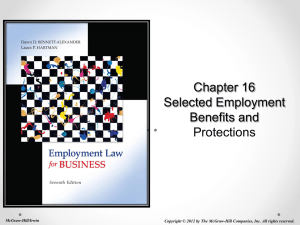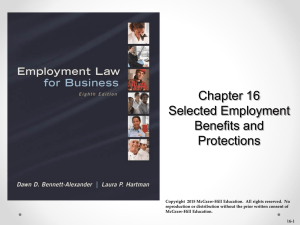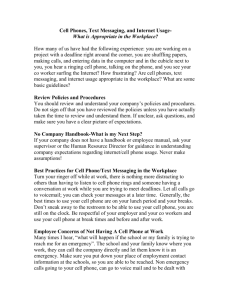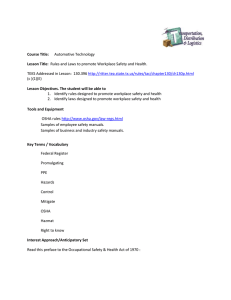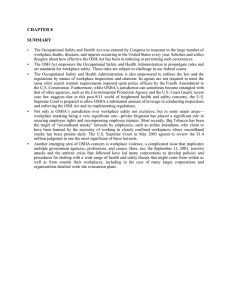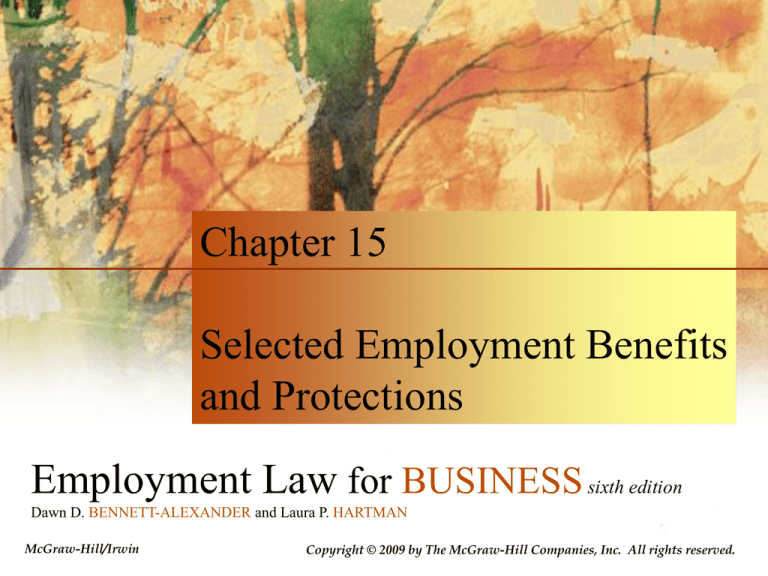
Chapter 15
Selected Employment Benefits
and Protections
Employment Law for BUSINESS sixth edition
Dawn D. BENNETT-ALEXANDER and Laura P. HARTMAN
McGraw-Hill/Irwin
Copyright © 2009 by The McGraw-Hill Companies, Inc. All rights reserved.
Fair Labor Standards Act
Statutory Basis
Every employer shall pay to each of his employees who in any
workweek is engaged in commerce or in the production of goods
for commerce, or is employed in an enterprise engaged in
commerce or in the production of goods for commerce, wages at
the following rates: . . . not less than $5.15 an hour beginning
September 1, 1997. Sec. 6(a),
Fair Labor Standards Act of 1938, as amended, 29 USC 201, et
seq.
. . . No employer shall employ any of his employees for a
workweek longer than forty hours unless such employee receives
compensation for his employment in excess of the hours above
specified at a rate not less than one and one-half times the regular
rate at which he is employed. Sec. 7(a)(1), Fair Labor Standards
Act of 1938, as amended, 29 USC 201, et seq.
15 – 2
Show me the Money!
• Fair Labor Standards Act (FLSA)
L01
– Law to regulate pay and hours worked passed in
1938
– Set standards for minimum wage
– Prohibits pay differentials based solely on gender
• FLSA is administered by the U.S. Department
of Labor’s Wage and Hour Division
– States also have wage and hour provisions
administered by comparable state agencies
• Regulates child labor, wages and hours
• Requires records on wages and hours
• Violations
15 – 3
Covered Employees
• Two types of coverage in FLSA:
– Individual coverage
– Enterprise coverage
• The law applies to both part-time and full-time
employees
• Federal, state and local employees are covered
• The law also covers domestic service workers
• There are exemptions
15 – 4
Minimum Wages
L02
• The minimum wage law was established after
WWII in hopes that it would avoid another
depression
• Under FLSA, employers are required to pay
covered employees a certain minimum hourly
wage
• State wage laws may have higher minimums
than the federal law
• Time and a half pay
• Subminimum wage employees
• Tipped employees
15 – 5
Minimum Wages (continued)
• Not everyone is covered under the statute
• Primary exemptions
• Rule change from August 2004
– Prior to the rule change, salary levels used in
the wage and hour rules had not been
updated for nearly 30 years
– Employees earning up to $23,660 per year
($455/week) are automatically entitled to
overtime pay
15 – 6
Minimum Wages (continued)
• Executive employees are exempt if they:
– Manage two or more employees
– Have firing, hiring and promotion authority
• Employees who earn at least $100,000 per
year and perform some executive,
professional, or administrative job duties are
automatically exempt from overtime
provisions
• Back wages
15 – 7
Overtime Provisions
• FLSA does not limit the hours
employees work, but, rather, sets
standards for the hours constituting a
normal workweek for wage purposes
• Sets wage rates for hours worked over
and above the normal week
• If an employee works over 40 hours, he
or she must be paid time and a half for the
time worked in excess of 40 hours
15 – 8
Child Labor Laws
• FLSA sets minimum age standards for
allowing children to work
– Most cannot work before age 16
– Age 18 the minimum for hazardous jobs
– Certain jobs allowed for children 14-16 that
do not interfere with their health, education,
or well-being
• State child labor laws override federal
law
15 – 9
Family and Medical Leave Act
Statutory Basis
Leave Requirement
(a) (1) Entitlement to leave—an eligible employee shall be entitled to a total of
12 workweeks of leave during any 12-month period for one or more of the
following:
(A) Because of the birth of a son or daughter of the employee and in order to
care for such son or daughter.
(B) Because of the placement of a son or daughter with the employee for
adoption or foster care.
(C) In order to care for the spouse, or a son, daughter, or parent, of the
employee, if such spouse, son, daughter, or parent has a serious health
condition.
(D) Because of a serious health condition that makes the employee unable
to perform the functions of the position of such employee. [The Family
and Medical Leave Act of 1993, 29 U.S.C. § 2601 et seq.]
15 – 10
Family and Medical Leave Act
• FLMA was enacted primarily in response to job
retention after having a child
– Now much broader scope
L03
• General provisions
– Guarantee job after leave for a birth, an adoption, or
care of sick children, spouses, or parents
– Applies to employers with 50 or more employees
within a 75-mile radius
– Employers can require medical confirmation of an
illness
– Leave is unpaid
15 – 11
Occupational Safety and Health Act
Statutory Basis
§654 (§5) Duties
(a) Each employer—
(1) shall furnish to each of his employees employment
and a place of employment which are free from
recognized hazards that are causing or are likely to
cause death or serious physical harm to his employees;
(2) shall comply with occupational safety and health
standards promulgated under this Act.
(b) Each employee shall comply with occupational safety
and health standards and all rules, regulations and
orders issued pursuant to this Act which are applicable
to his own actions and conduct.
15 – 12
Safety at Work
• Each year:
– 5,700 Americans die from workplace injuries
– 50,000 die from illnesses caused by
workplace exposure
– 4.7 million suffer nonfatal workplace injuries
• OSHA claims that since 1971, the act has
helped cut workplace fatalities by more
than 60 percent and injury/illness by 40
percent
15 – 13
General Provisions
L04
L05
• OSHA requires that an employer provide a safe
workplace
• Contributory negligence
• Assumption of risk
• Fellow servant rule
• Worker’s limited in financial recovery, but may
now obtain relief from hazardous situations
• Section 5(a)
– The employer must comply with all the safety and
health standards dictated by the Department of
Labor
– The employer must furnish a workplace fee of
hazards
15 – 14
General Provisions (continued)
L06
• OSHA creates certain specific regulatory
standards of safety
• OSHA conducts routine inspections in certain
high-risk industries
• Penalties and “abatement orders” are assessed
in connection with an inspection officer’s report
• Employers covered by the Act must maintain
records for OSHA compliance
• Employees must be informed of their OSHA
rights by their employer
15 – 15
Procedure for Enforcement
• Responsibility for enforcing the acts rests
with OSHA under the auspices of the
Department of Labor
• Occupational Safety and Health Review
Commission
• “Willfulness”
– Increase in fines
– Definition of “willful”
15 – 16
Specific Regulations
•
•
•
•
•
•
•
•
Physical layout of the worksite
Training
Medical examinations
Setting standards
Voluntary compliance programs
Continual-training requirement
Emergency temporary standards
Continual training requirement
15 – 17
Employee Benefits
Statutory Basis
Employee Retirement Income Security Act
§ 1132. Civil Enforcement.
(a) A civil action may be brought—
(1) By a participant or beneficiary—
(B) to recover benefits due to him under the terms of his plan, to
enforce his rights under the terms of the plan, or to clarify his
rights to future benefits under the terms of the plan.
§ 1140. Interference with protected rights.
It shall be unlawful for any person to discharge, fine,
suspend, expel, discipline, or discriminate against a
participant or beneficiary for exercising any right to
which he is entitled under the provisions of an
employee benefit plan, or for the purpose of interfering
with the attainment of any right to which such
participant may become entitled under the plan.
15 – 18
Will It Be There When I Retire?
L07
• Although not required, many firms offer
employees retirement plans, health care,
and other employee benefits
• To protect pension benefits of workers,
Congress enacted the Employee
Retirement Income Security Act (ERISA)
15 – 19
ERISA
L08
• Does not cover plans by government
entities, churches, non U.S. residents, or
independent contractors
• ERISA covers welfare plans and
retirement or pension plans
• Reporting and disclosure
– The employer must provide information to
each participant and the federal government
– Summary plan description (SPD)
• Pension Protection Act of 2006
15 – 20
ERISA (continued)
• Fiduciary duty
–
–
–
–
–
Loyalty
Exclusive purpose
Prudence
Diversification
Compliance with plan documents
• Eligibility and vesting rules
• Funding requirements for defined benefit plans
• ERISA litigation
15 – 21
ERISA (continued)
• Consolidated Omnibus Budget
Reconciliation Act (COBRA)
• Health Insurance Portability and
Accountability Act (HIPAA)
– HIPAA privacy rules
– General obligations of covered entities
• Enforcement of ERISA
15 – 22
Summary
• Employers must be aware that employees have certain rights due to
them under various statutes.
• Children below a certain age may not be employed except as
specified by law, and there are only certain hours they can work
and certain jobs they can do.
• By law, employees who have worked for an employer for at least
12 months are entitled to take up to 12 weeks’ unpaid leave for
under certain circumstances without job loss.
• Employees have a right to a safe workplace, and OSHA is there to
help protect that right. Employers are not required to provide
workplace benefits and retirement plans for their employees, but if
they do they must follow applicable laws.
• An awareness of these workplace rules is a must for an employer
who wishes to avoid federal and state liability for violations.
15 – 23

